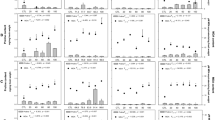Abstract
Assimilation of 35S-precursors into microbial proteins was used to investigate toxicity and adaptational responses that occur in nutrient enriched and natural freshwater samples experimentally contaminated with benzene, toluene, trichloroethylene (TCE), or xylene. Experiments were conducted to analyze (1) the potential of using microbial community protein profiles for responsive identification of chemical pollutant exposure, (2) the inhibition of microbial productivity through reduction in rate of protein synthesis caused by specific chemical pollutants, and (3) whether selection of subpopulations in freshwater microbial communities challenged with chemical pollutants leads to adaptive strategies mediated by production of particular polypeptides. The results show that distinct banding patterns of polypeptides in the range of 30 to 100 kilodaltons that were obtained following collective cultivation of freshwater microorganisms differ with each chemical pollutant. Protein yield and radioisotope incorporation were reduced within ten minutes of microbial exposure to chemical pollutants in the following order: xylene < toluene < benzene < TCE. Adaptation of the freshwater microbial community to chemical pollutants prior to radioisotope incorporation produced differences in polypeptide profiles, in the banding patterns of radioactive polypeptides, and in the rate of radioisotope incorporation. The rate of radioisotope incorporation by freshwater microorganisms pre-adapted to chemical pollutants was lowest with xylene (88.1% reduction), followed by TCE (84.0% reduction), toluene (67.3% reduction), and benzene (43.5% reduction). In long-term radioisotope incorporation experiments, protein yield and polypeptide radioactivity was higher in the presence of chemical pollutants than in uncontaminated control samples, suggesting increased metabolic productivity attributable to the chemical pollutants.
Similar content being viewed by others
References
Berry RJ, Crawford TJ, Hewitt GM (eds) (1992) Genes in Ecology. Blackwell Scientific, Oxford
Blom A, Harder W, Matin A (1992) Unique and overlapping stress proteins of Escherichia coli. Appl Environ Microbiol 58:331–334
Clesceri LS, Greenberg AE, Trussel RR (eds) (1989) Standard methods for the examination of water and wastewater. American Public Health Association. Washington, DC, pp 4–207
Davies J (1994) Microbial molecular diversity: past and present. J Ind Microbiol 13:208–211
Fuhrman JA, Azam F (1982) Thymidine incorporation as a measure of heterotrophic bacterioplankton production in marine surface waters: evaluation and field studies. Mar Biol 66:109–120
Garcia-Cantizano J, Calderon-Paz JI, Pedros-Alio C (1994) Thymidine incorporation in Lake Ciso: problems in estimating bacterial secondary production across oxic-anoxic interfaces. FEMS Microbiol Ecol 14:53–64
Gilmour CC, Leavitt ME, Shiaris MP (1990) Evidence against incorporation of exogenous thymidine by sulfate-reducing bacteria. Limnol Oceanogr 36:1401–1409
Hofle MG (1992) Bacterioplankton community structure and dynamics after large-scale release of nonindigenous bacteria as revealed by low-molecular-weight-RNA analysis. Appl Environ Microbiol 58:3387–3394
Jannasch HW, Wirsen CO, Molyneaux SJ, Langworthy TA (1992) Comparative physiological studies on hyperthermophilic archaea isolated from deep-sea hot vents with emphasis on Pyrococcus strain GB-D. Appl Environ Microbiol 58:3472–3481
Jorgensen NOG (1992a) Incorporation of [3H]leucine and [3H]valine into protein of freshwater bacteria: uptake kinetics and intracellular isotope dilution. Appl Environ Microbiol 58:3638–3636
Jorgensen NOG (1992b) Incorporation of [3H]leucine and [3H]valine into protein of freshwater bacteria: field applications. Appl Environ Microbiol 58:3647–3653
Kaplan LA, Bott TL, Bielicki JF (1992) Assessment of [3H]thymidine incorporation into DNA as a method to determine bacterial productivity in stream bed sediments. Appl Environ Microbiol 58:3614–3621
Kersters K, De Ley J (1980) Classification and identification of bacteria by electrophoresis of their proteins. In: microbiological classification and identification. Goodfellow M, Board RG (eds) pp. Soc Appl Bact Symp Se, Academic Press, London 8:273–297
Kirchman DL, K'Nees E, Hodson R (1985) Leucine incorporation and its potential as a measure of protein synthesis by bacteria in natural aquatic systems. Appl Environ Microbiol 49:599–607
Levin MA, Seidler RJ, Rogul M (eds) (1992) microbial ecology: principles, methods, and applications. McGraw-Hill, New York
McDonough RJ, Sanders RW, Porter KG, Kirchman DL (1986) Depth distribution of bacterial production in a stratified lake with an anoxic hypolimnion. Appl Environ Microbiol 52:992–1000
Muyzer G, de Waal EC, Uitterlinden G (1993) Profiling of complex microbial populations by denaturing gradient gel electrophoresis analysis of polymerase chain reaction-amplified genes encoding for 16S rRNA. Appl Environ Microbiol 59:695–700
Ogunseitan OA (1993) Direct extraction of proteins from environmental samples. J Microbiol Methods 17:273–281
Ogunseitan OA, Olson BH (1993) Effect of 2-hydroxybenzoate on the rate of naphthalene mineralization in soil. Appl Microbiol Biotechnol 38:799–807
Sambrook J, Fritsch E, Maniatis T (1989) Molecular cloning, vol 3. Cold Spring Harbor Labortory Press, New York
Sayler GS, Layton AC (1990) Environmental application of nucleic acid hybridization. Annu Rev Microbiol 44:625–648
Tebbe CC, Ogunseitan OA, Rochelle PA, Tsai Y-L, Olson BH (1992) Varied responses in the gene expression of heterotrophic bacteria isolated from the environment. Appl Microbiol Biotechnol 37:818–824
Van der Kooij D, Visser A, Hijnen WAM (1982) Determining the concentration of easily assimilable organic carbon in drinking water. J Am Water Works Assoc 14:540–545
Voordouw G, Voordouw JK, Jack TR, Foght J, Fedorak PM, Westlake DW (1992) Identification of distinct communities of sulfate-reducing bacteria in oil fields by reverse sample genomic probing. App. Environ Microbiol 58:3542–3552
Author information
Authors and Affiliations
Additional information
Correspondence to: O.A. Ogunseitan.
Rights and permissions
About this article
Cite this article
Ogunseitan, O.A. Protein profile variation in cultivated and native freshwater microorganisms exposed to chemical environmental pollutants. Microb Ecol 31, 291–304 (1996). https://doi.org/10.1007/BF00171573
Received:
Revised:
Issue Date:
DOI: https://doi.org/10.1007/BF00171573




